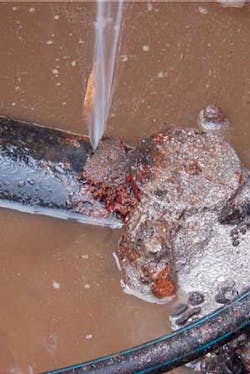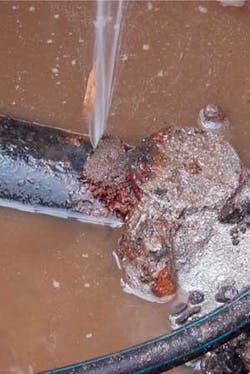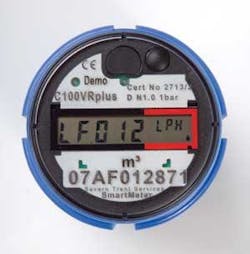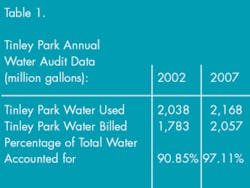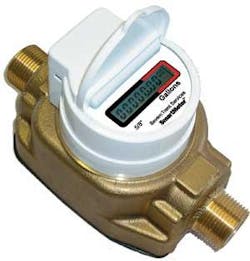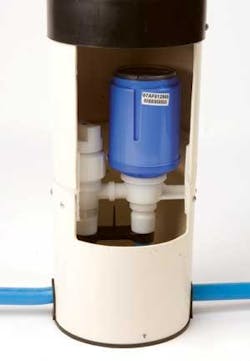Smart Meters Cut Leaks, Improve Efficiency
By Fran House
UK manufactured intelligent water meters from Severn Trent Services help reduce non-revenue water (NRW) and detect leaks for Illinois village in the USA.
The problems associated with supply pipe leakage have long been understood, but the gravity of the problem and benefits of employing new metering technologies to address water loss haven’t been as universally appreciated.
The facts:
- Supply pipe water loss results in lost revenue for water companies.
- Higher leakage rates inflate water companies’ energy costs.
- Leakage means supply pressure and flow to customers can be affected.
- Long term leaks can cause extensive and expensive damage.
- Leaks increase the risk of air in the pipework.
- UK trials in 2007 indicate eight times more domestic properties are affected by leakage than currently estimated.
- The same trials show the average leak is significantly higher than current estimations.
Despite these facts:
- Water companies continue to underestimate the extent of their lost water.
- The take-up of domestic metering technologies developed to directly address the problem is very slow.
- The average domestic leak still consumes 24,000 litres every month.
- Substantial money and energy is wasted by pumping water into a network affected by supply pipe leakage.
New Metering Technologies
New metering technologies are revolutionising the water industry, not only offering a valuable tool in solving the problem of water loss, but, more broadly, offering substantial benefits for control of the water supply. New solutions now available enable increased accuracy, reliability and quality of information for high volume residential metering businesses. Information delivered by advanced metering technologies can be used to address water scarcity issues, on both the demand and supply side. Initiatives such as tariff application can address the issue of demand, and improved leakage detection and quantification can help increase the available supply of water.
One of these technologies, SmartMeter™ no moving parts meters from Severn Trent Metering Services based in the UK, provides advantages over traditional mechanical meters ranging from dependable long-term accuracy; tolerance to grit and air; fewer customer disputes; and more workable pre-payment systems. This intelligent water meter is AMR enabled as standard.
In addition, the whole life accuracy has demonstrable benefits in the prevention of lost revenue. Declining accuracy of mechanical meters can be measured and analysed in relation to the billing revenue generated by the water company. Some water suppliers, including the water department of a village in the U.S. Midwest, have undertaken testing and analysis to determine the amount of revenue they were losing and have developed replacement strategies for their mechanical water meters.
Major water companies increasingly ask for, and in some cases exclusively specify, the requirement for no moving parts meters. The growing interest in this technology is expanding a base of installations and research taking place across the globe – from the Middle East to Australia, and from the USA, India and Korea to Micronesian islands in the Pacific.
Among makers of intelligent water metering devices, one of those with the most experience with these meters and with the largest number of residential installations is Severn Trent Metering Services. It’s smart water meters have been instrumental in helping water companies around the world to detect leaks, reduce Non-Revenue Water (NRW), and ultimately manage scarce water supplies.
Concentric meter data
Designed and test trialed by seven UK water companies, the SmartMeter C100 water meter reduces water loss by enabling effective leakage management and supporting the application of complex tariffs to curb demand. When designing the meter, an important requirement was the ability to differentiate between leakage and legitimate use to assist in billing and prioritisation of supply pipe leak repairs. A detailed specification was developed, which included leakage data (location, rate, duration and date); the need for varied tariff application; an efficient AMR system; flexibility to enable migration between different reading technologies; and peak-week demand data.
Conventional wisdom in the UK water industry is that perhaps 1% of properties suffer from a leaking supply pipe at any one time. As with the study cited above, findings from a survey of the C100 meters installed by Severn Trent Services indicate the incidence of leaks may be significantly higher than previously thought, with 6.8% of meters installed to date reporting leaks of more than 24 hours in duration. One% of meters showed leaks that were still ongoing.
Data from the meters installed also has clearly indicated the proportion of consumption made up by leaks can be very high. This is particularly important, as only meters with excessive total consumption would be considered for a “kick-out” of the water bill, where the water company would investigate potential leaks and provide discounts accordingly. Such kick-outs occur regardless of whether excessive consumption was caused by actual legitimate use or a supply pipe leak. Consequently, a leak could be disguised on a single occupancy property if metered consumption fell below that of the average house with multiple residents.
In some instances, the C100 has identified leaks that account for 50% of the water bill. These, however, may well have gone undetected. Water companies have difficulty in predicting the range of consumption without knowledge of the number of people living in the property. Initial data from the trial shows the ratio of leaks compared to actual water used varies significantly, but has reached as high as [a minimum of] 74% in one case.
Another significant finding showed the distribution of leaks to be weighted heavily towards the smaller size flow rates, with events up to 20 litres per hour accounting for 58% of all leaks. Current theory on UK leakage levels is based on known data. Water companies rely on a series of techniques to detect leaks ranging from anomalies identified by the billing system software, local area analysis and, to some extent, guesswork. These techniques lend themselves to identifying large leaks, but are unlikely to detect a leak below 20 litres an hour, which could equate to a dripping tap. Over the course of a year, this could amount to as much as 175.2 m3 of water that a metered customer would pay for, but would not consume.
Intelligent Water Meters
With the growing concern over aging infrastructure, municipal and private water departments across the United States are relying on water revenue to offset costs associated with capital improvements. While water main breaks are a major contributor of water loss, municipalities large and small also must account for a silent culprit – water usage that’s either not metered or metered improperly due to poor meter performance.
One village in Illinois began working toward the goal of fully metering its system in order to account for all water usage. Seven years later, the Village of Tinley Park has eliminated water loss – the first municipality in the state of Illinois to do so. As one of 118 communities to receive water from Lake Michigan, Tinley Park currently has more than 23,000 connections. Since 2002, water usage billed by the village has increased nearly seven%.
The sharp reduction in water loss coincides with the village’s decision to replace its base of mechanical water meters with intelligent water meters from Severn Trent Services.
In 2002, Tinley Park purchased 5,000 meters; subsequent orders followed. In 2005, the village’s board approved a contract meter replacement program. Averaging 120 meter replacements per month, more than 18,000 advanced water meters have been installed through April 2008. In the village’s 2009 fiscal year, 3,500 additional meters are scheduled for installation.
Conclusion
The benefits associated with water meters without moving parts, such as whole life accuracy, have contributed to Tinley Park’s reduction in lost revenue. This has enabled early leak detection and has helped establish water usage patterns and corresponding water rates. The village has been able to detect when consumption is low or zero – a common occurrence due to residents’ winter travel. In addition, SmartMeter water meters have been responsible for water conservation, which is especially important during periods of drought such as the one the Village endured in 2005.
Recent meter accuracy testing in accordance with Illinois state guidelines show Tinley Park is accounting for 100.3% of all water. With all water accounted for, the village is focusing on the year 2013 when recovered revenue will surpass their investment in the Severn Trent Services water meters. WWi
Author’s Note:
Fran House is a marketing manager for Severn Trent Services Ltd. Contact: +44 121 313 2300, [email protected] or www.severntrentservices.com
